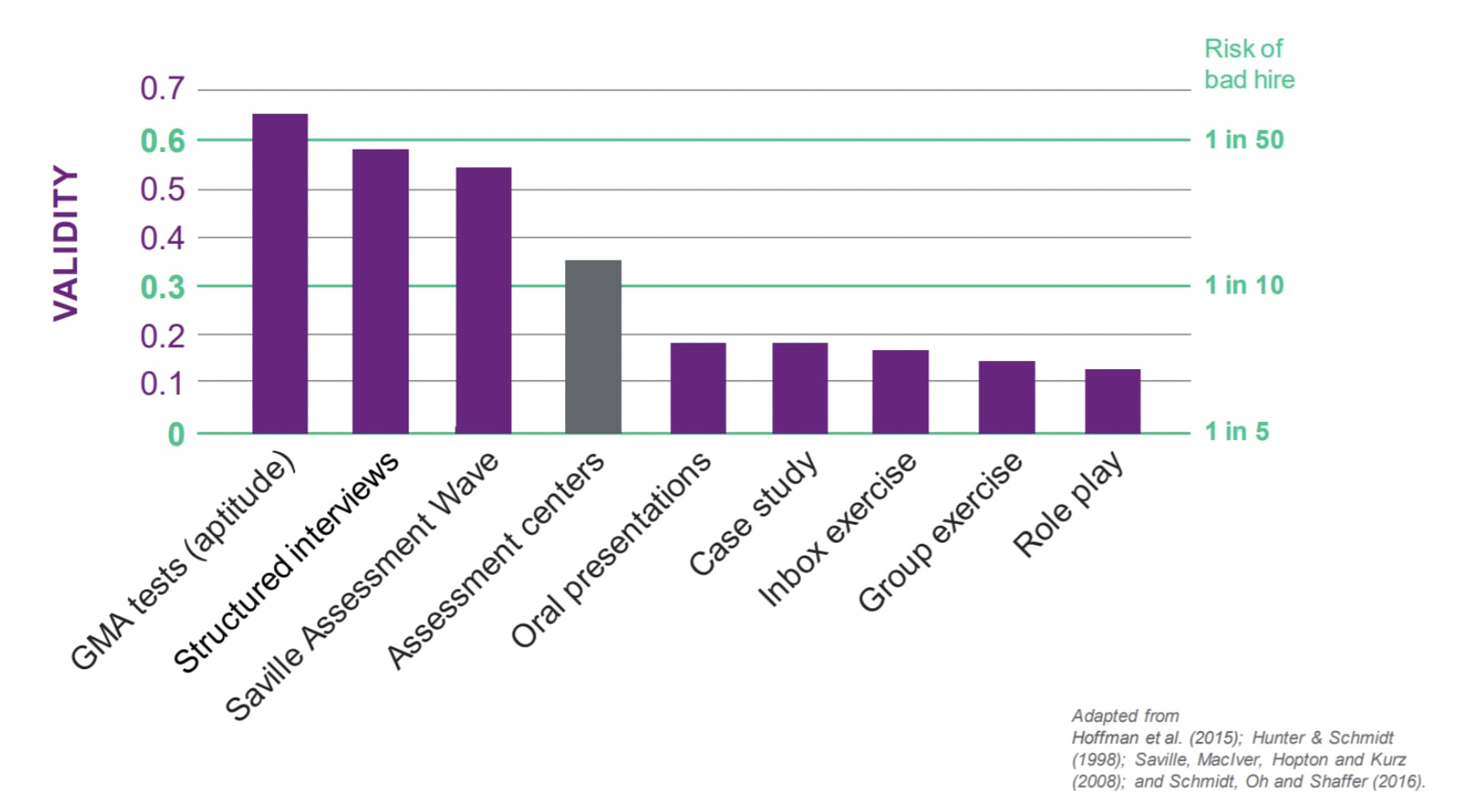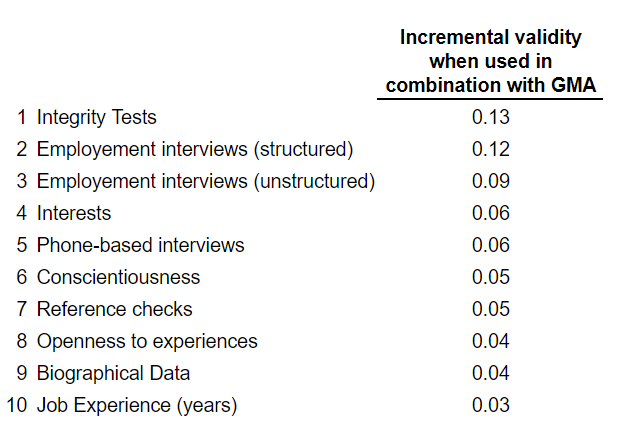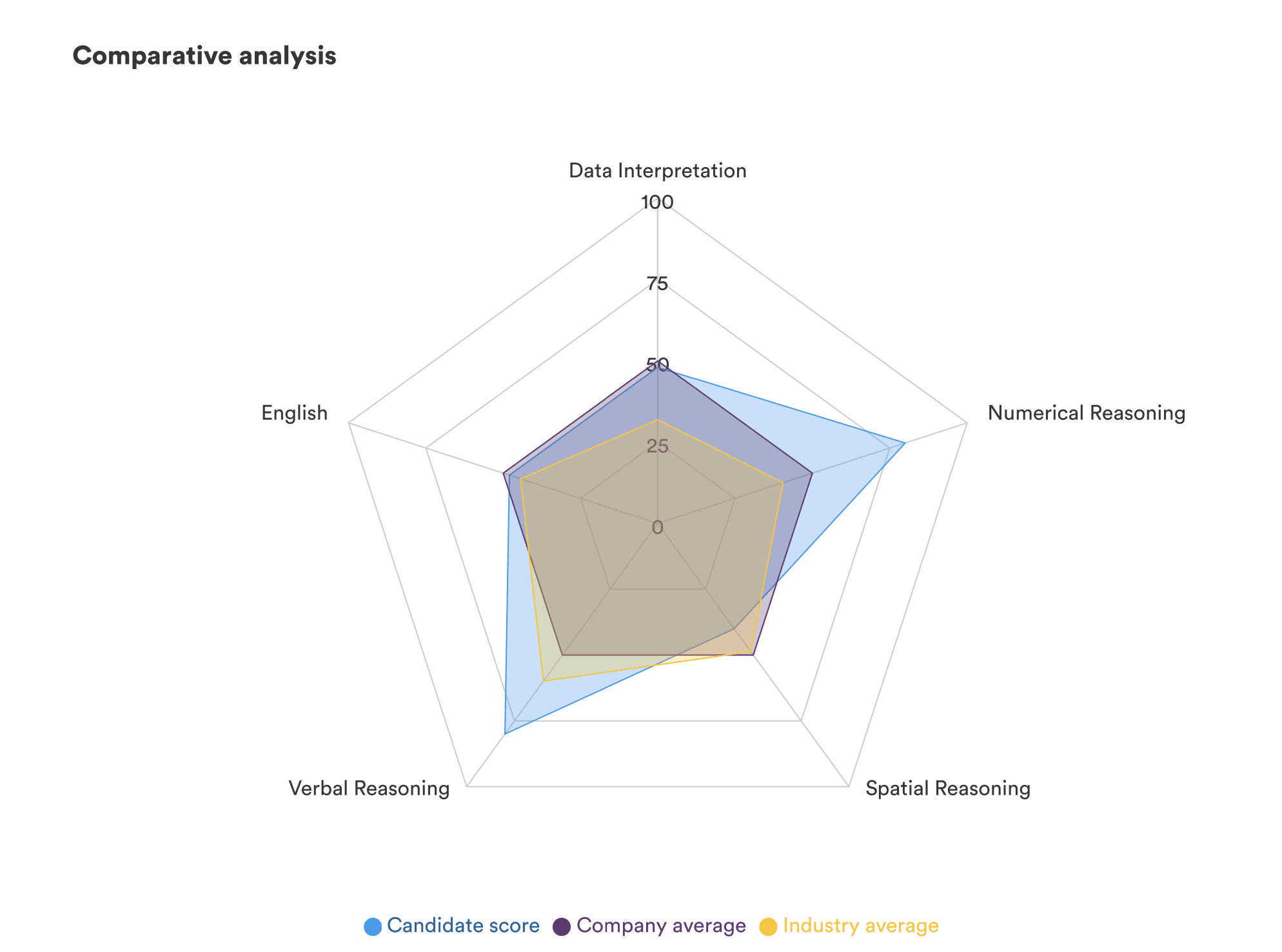

Two candidates applied for the same role at a tech company.
Candidate 1:
- Has 3+ years of job experience
- Has a stellar CV
- Has amazing credentials
- But scored low on the GMA test
Candidate 2:
- Has 1.5 years of experience
- Has a decent CV
- Has average credentials
- But scored very high on the GMA test
After getting through the recruitment process (CV checks, initial conversations and taking the GMA test), who do you think has a higher chance of getting selected?
You'd say candidate 1. But the second candidate has a higher chance of solid future performance.
Here's why:
- According to scientific research, it is proven that the best job performance indicators are cognitive ability, work sample tests, integrity tests, and structured interviews.
- Among these, cognitive ability is the most relevant predictor.
Schmidt and Hunter, whose research on the validity and utility of selection methods in personnel psychology we analyze below, have published some of the most influential research on valid talent selection methods.
By the end of this blog, you'll have a solid understanding of the science behind GMA, what the research tells us about GMA tests in the hiring process and how to create efficient aptitude tests for your business.
First, let's start with understanding different layers of human intelligence.
The science behind General Mental Ability
The Cattell-Horn-Carroll (CHC) model of intelligence (as shown in the picture below) explains how and why individuals differ in cognitive ability.

The diagram presents three levels of cognition:
- Narrow abilities (stratum I) are an extended list of verbal, numerical, and spatial reasoning abilities.
- Broad abilities (stratum II) are "fluid" and "crystallized" intelligence, other aspects of memory, processing speed, and different core abilities.
- General abilities (stratum III, "G") denotes GMA. It tops the hierarchical structure because it summates all other parts. In other words, it implies there's a bit of GMA in all aspects of intelligence.
The CHC theory of intelligence tells us that if you want a candidate with solid reasoning fundamentals (as in Stratus II or Stratum III), you should test their GMA.
Different elements of GMA (General Mental Ability)
General Mental Ability (GMA) predicts the level at which an individual learns, understands directions, and gets things done.
Typically, GMA tests measure the following dimensions:
- General knowledge: The extent to which an individual has acquired information on various topics.
- Social Intelligence: The ability to assess social conduct and apply moral and ethical norms.
- Arithmetic: Numerical thinking and problem-solving skills.
- Verbal concepts: The ability to categorize, conceptualize similarities and contrasts, and draw nuanced comparisons.
- Vocabulary: The extent to which linguistic concepts have been acquired. Indicates communication skills, receptivity to knowledge, and the capacity to use information successfully.
- Coding: Adaptability and learning speed.
- Detail orientation: The ability to detect crucial details through perceptual and intellectual abilities.
- Spatial rotation: The ability to see objects in different dimensions and perspectives.
- Spatial reasoning: The ability to see how diverse components of an item fit together.
Why are aptitude tests important?
Aptitude tests complement other recruitment methods. Once the primary stages (analyzing job requirements, preparing job descriptions, and sourcing) are completed, aptitude tests can be used to eliminate irrelevant applicants before the interview stage.
Because interviews are costly and time-consuming, testing applicants on aptitude tests before the interview stage can be cost-effective.
Aptitude test reports can help recruiters observe specific traits and behaviours in applicants to determine their suitability for a role. Moreover, when finalizing a candidate, employers can go back to assessment reports to differentiate between candidates that seem to be at par in education level, competence, etc.
The need for aptitude tests in the modern recruitment process
The workforce and its working styles are evolving, further accelerated by the pandemic. Jobs are becoming more flexible, and employees now prefer jobs that offer a healthy work-life balance.
Therefore, businesses have started responding with a recruitment strategy that aligns with these market changes to avoid missing out on a competitive workforce.
Additionally, recruiters needs a strategy that offsets issues with current hiring methods:
- Candidates may "over prepare" resumes.
- Educational achievements may not indicate individual capabilities correctly.
- Candidates may "over prepare" for interviews.
- An interviewer can be biased.
- Increased costs and legal risks of firing.
- Lack of reference checks from previous jobs.
The newly developed strategy is to complement traditional recruitment methods with aptitude tests. Aptitude tests are being implemented actively in industries like finance, marketing, legal, etc. According to an SHRM survey, 18% of companies use aptitude tests, which is growing by 10% to 15% annually.
Next, let's explore what scientific research reveals about General Mental Ability.
GMA is the most valid predictor of employees' future performance and learning.
In the chart below, we break down 85 years of research in personnel psychology concerning the validity of 19 hiring methods.

Research data comparing various recruiting methods and their effectiveness in identifying suitable candidates. The greater the number, the better. It is worth noting that GMA surpasses everything, even in-person interviews.
Note: These coefficients vary from -1.0 to +1.0, and a value of 0.35 or above is considered highly favourable in selection tests.
The research was done by Schmidt and Hunter comparing different hiring techniques and their effectiveness as a predictor of long-term performance.
They found GMA to be a much better predictor of long-term performance, even when job knowledge is considered. They also concluded that employees with high GMA could build on prior knowledge and make decisions even in unfamiliar situations.
The overall data indicates that:
- The best performance indicators include cognitive capability, work sample tests, integrity tests, and structured interviews.
- Schmidt and Hunter proved that general mental ability (GMA) strongly correlates with job success compared to resumes.
- Experience and education (part of resumes) have just a 0.13/1 and 0.10/1 correlation with work success, respectively—unlikely to be beneficial assessment methods.
- General mental ability has a correlation coefficient of 0.65/1—a highly beneficial assessment method.
Schmidt and Hunter also discuss the ROI of candidate selection methods. They emphasize that organizations may transform a competitive disadvantage into a competitive advantage by implementing more valid recruiting methods.

- Hiring based on traditional assessments gives 1 in 10 bad hires, whereas 1 in 5 when no assessment is used.
- And here's the most interesting one–hiring based on GMA tests gives only 1 in 50 bad hires!
- In economic terms, the benefits of improving the legitimacy of recruiting techniques can amount to millions of dollars over time. From another perspective, an organization might lose millions of dollars by using conventional selection methods.
Schmidt and Hunter further expanded their research into pairing different hiring techniques to find the best combination to predict long-term performance.
The same research combines GMA with other recruiting methods to determine predictive validity. The greater the number, the more effective it is in finding suitable candidates.

Predictive validity is the best measure of evaluating and predicting a candidate's future performance and on-the-job learning capabilities. Hiring strategies with higher predictive validity result in significant gains in employee performance.
Aptitude vs ability
GMA exams, integrity tests, and interviews outperform traditional resume-based recruiting methods by a huge margin! Pairing aptitude tests with any kind of hiring method vastly exceeds their validity compared to without aptitude tests.
3 key takeaways
- Using aptitude tests gives you 1 in 50 bad hires vs 1 in 5 when not using them.
- Using aptitude tests is highly beneficial as they outperform traditional recruiting methods like resumes by a 5x margin.
- Aptitude tests give the best results combined with integrity tests and structured interviews.
Recruiting managers must employ a variety of techniques to make hiring decisions. The validity of various approaches and combinations of methodologies for forecasting future work performance varies.
The two combinations with the highest validity are GMA and integrity tests (.65) and GMA and structured interviews (.63). Both methods are cost-efficient and can be used to hire experienced or inexperienced candidates.
Aptitude tests in action
So far, all we have covered seems like a lot to take in, right? Don't worry. The in-house team at Adaface boiled down the key findings from this research to create perfect aptitude tests at Adaface. Here's what we do that you can include in your aptitude tests as well:
In-depth customization
Why customize?
Most recruiters think they can use the same off-the-shelf aptitude test for different roles.
Here's that doesn't get you optimal outcomes.
Every profession has unique requirements, and performing them takes a specialized skill set. Recruiters must understand which aptitude test is most suited to their testing needs.
We solve that problem by breaking aptitude into sub-categories (like numerical reasoning, verbal reasoning, attention-to-detail, data analysis, etc.). Each role requires different proportions and difficulty levels of these sub-categories to get you the right candidates.
Let's understand why with examples:
- If you're hiring for entry-level data roles, testing candidates on attention-to-detail would give you a better idea of their skillset.
- Sales roles require more of the "situational judgement" sub-category than numerical reasoning.
- For a client from the EU hiring candidates from Asia, "verbal reasoning" becomes an essential category vs if you're hiring candidates from the US.
- Questions are designed based on job descriptions. Numerical reasoning questions for data analysis roles should be based on data consuming and distilling topics instead of focusing on numerical puzzles because puzzles have nothing to do with on-the-job numerical aptitude.
- Therefore, it's always in an employer's best interest to not use the same off-the-shelf test for different roles.
Granular scoring
Every aptitude test (including Adaface aptitude tests) gives you an overall number of how the candidate performs (like 55/100). But what you need is something far more granular. Candidate scores are broken down into key important sub-categories for each role.
Here's an example of comparative analysis and skills profile aptitude scorecards.


How do aptitude tests help in recruitment
- The candidate score vs. industry/company average helps you determine whether your overall talent is improving or declining over time. These granular insights can help you maintain a high average aptitude level for your hires and make better hiring decisions.
- Breakdown analysis helps you decide if the candidate is good or excellent and if they have the must-have skills for a role.
- For example: For a sales role, you would want the candidate to score exceptionally in situational judgement and communication skills, and you would be ok if the candidate performs lesser on numerical reasoning. The reverse would be true for data entry roles.
- Two candidates having identical overall scores will perform entirely differently on the job. Having a detailed breakdown is the key to understanding who is the perfect fit between the two.
Use a reliable aptitude testing platform that provides:
- Customizable questions on topics and difficulty levels
- Non-binary scoring
- Non-googelable questions
- Detailed sub-category level breakdown
What's next?
The strongest predictors of job performance are cognitive ability tests, work sample tests, integrity tests, and structured interviews.
Research repeatedly proves the devastating impacts of invalid selection methods (like resumes, job experience and education) on businesses and their overall efficiency.
And the answer to this is–aptitude tests that have existed all along.
80% of Fortune 500 companies and more than 75% of the Times Top 100 companies are already using aptitude tests for hiring.
If that doesn't convince you, then here's something that surely will–using aptitude tests for hiring gives a business just 1 in 50 bad hires vs. 1 in 5 if they doesn't use aptitude tests.
They provide a better insight into a candidate's personality, integrity, ability to fit into an existing team, and additionally eliminate the possibility of unconscious bias from recruiters.
Check out our aptitude tests to experience and understand how enterprises worldwide are benefiting from science backed hiring processes.

Sharad is a growth marketer at Adaface, he works to make his mitochondria proud. He is the guy responsible for making sure that every recruiter knows how Adaface can help them hire better.
Spending too much time screening candidates?
We make it easy for you to find the best candidates in your pipeline-
with a 40 min skills test.


